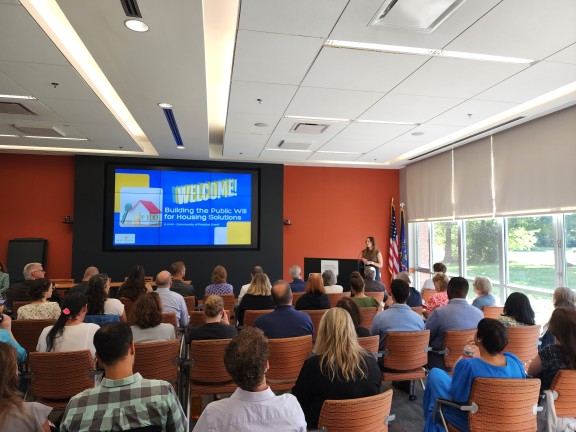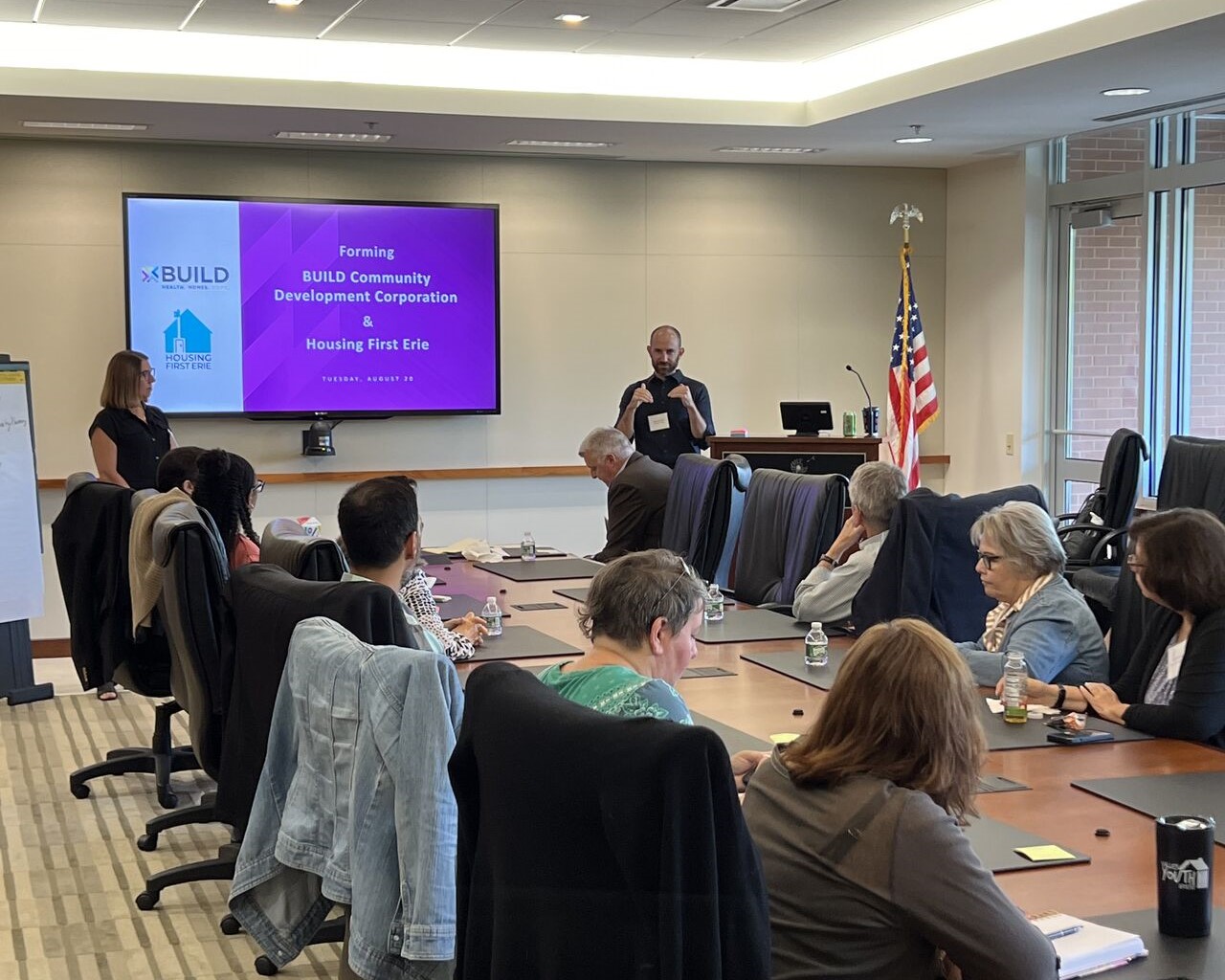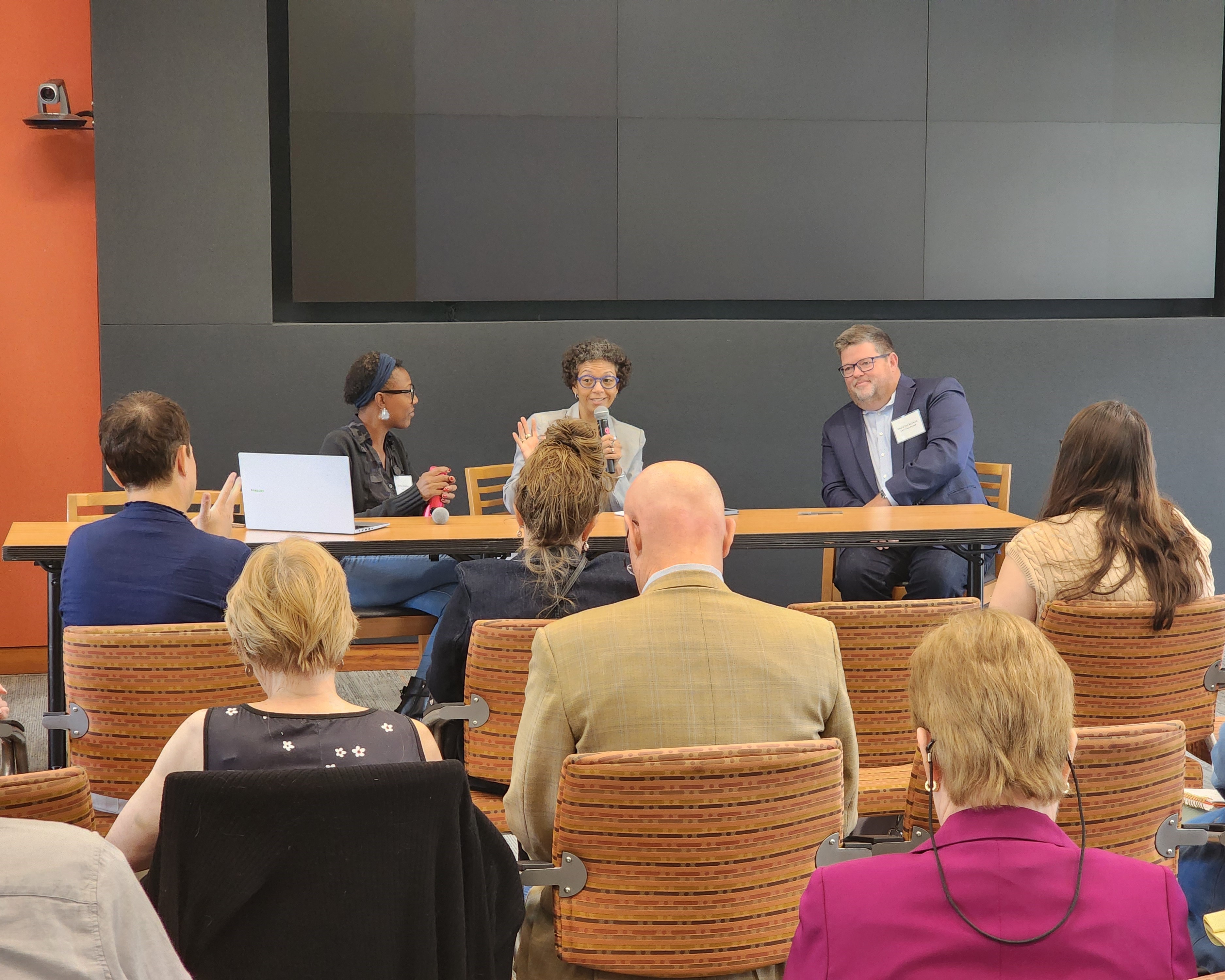Recap: Building the Public Will for Housing Solutions

Last week, attendees from 56 organizations including from offices of state and federal legislators, multiple Montgomery County Departments, and townships joined us for our mini-Community of Practice event "Building the Public Will for Housing Solutions."
Participants gathered for a half-day of networking and listening to learn new ideas and how to enhance communication around effective housing solutions.
This event was in response to an earlier Community of Practice, "Meeting the Moment: Taking Action on Homelessness and Affordable Housing in Montgomery County" that took place this past February. During that event, HealthSpark learned that many of our partners are interested in shaping a powerful narrative that speaks to the realities of the housing crisis and building their skills to not only communicate effectively with their colleagues, policymakers, and neighbors but to also strategize together on responsive solutions reflective of multiple community voices and intentional coordination.
All attendees tuned into our keynote panel ‘Education, Engagement, and Evidence-Based Research: Building an Effective Communications Strategy for Housing Solutions,’ before moving into facilitated roundtable discussions. The discussions featured two distinct topics ‘Unpacking Erie’s Housing First Approach’ and ‘Deep Dive: Narrative Change Opportunities in Montgomery County.’
We thank Commissioner Thomas DiBello, Representative Joe Webster, and staff from the offices of Senator Bob Casey and State Senator Amanda Cappelletti for joining us. In addition, thanks to Generocity for running their Community Newsroom onsite to capture attendee insight and feelings on this critical issue.
Our highlights below:
Education, Engagement, and Evidence-Based Research: Building an Effective Communications Strategy for Housing Solutions

HealthSpark President and CEO Emma Hertz moderated a conversation with Marisol Bello, Executive Director of national policy firm Housing Narrative Lab, Daria Devlin, Executive Director of Erie-based BUILD CDC, and Michael Gaudini, Land Use Consultant and Narberth Council Member, on what makes an effective narrative on housing, how to use communications research in your own work, and how to engage businesses, downtown associations, elected officials, and others to address homelessness in local communities.
Attendees learned:
- Successful messaging starts by being rooted in the shared values of community, love, pride, and empowerment,
- Narrative change happens through scale, consistency, and repetition by a vessel of coalition and collaboration.
- Storytelling is elemental to how we connect with people.
- It is imperative to include people with lived experience. For example, Daria shared her organization facilitated focus groups with the unhoused and asked them "What part of our community do you want to live in?" to balance their voices with the other voices engaged in building permanent supportive housing.
- To combat "Not in My Backyard (NIMBY)" attitudes, share narratives that speak to them, such as “If you give the unhoused housing, they will not frequent spots popular in communities, and needs are addressed.”
Unpacking Erie’s Housing First Approach

Daria Devlin, Director of Social Impact at Hamot Health Foundation and Executive Director at BUILD Community Development Corporation and Wyatt Schroeder, Executive Director of Hemlock and Forge shared their journey in centering Erie's approach to housing first by examining how they leveraged a Community Development Corporation (CDC) to drive new housing investments.
Attendees learned:
- The success of the Housing First Erie Project was driven by a collaborative partnership structure that united multiple missions for a unified goal. Entities not only included city and county government, but also a healthcare network and university in addition to others.
- These organizations identified their roles (rooted in the Collective Impact model), and strategized plans for housing formats, locations, integrated services, and the financial capital needed to advance project goals.
- The process to develop a community development partnership should kick off with a landscape review, move into coalition-building and community planning, transition into a focused pilot, and then scale accordingly.
- It’s important to bring to the conversation the possibility around the continuum of supporting housing affordability. This includes topics of workforce housing such as for hospital employees and helping to solve retention issues. By adding in another dynamic perspective, project buy-in and success can grow.
Deep Dive: Narrative Change Opportunities in Montgomery County

Marisol Bello, Executive Director at Housing Narrative Lab and Dionicia Roberson, Managing Editor at Generocity led a two-part roundtable discussion that included a participant-driven challenge share-out and brainstorming session, as well as a collaborative goal-setting exercise. The discussions focused on engaging people with lived experience in advocacy, overcoming "Not in My Backyard (NIMBY)" attitudes, boosting public investment, and fostering coalition-building across organizations to scale efforts.
Attendees learned:
- To think of narratives that would unite folks, including those with NIMBY attitudes together.
- It might be helpful to brainstorm and partner with folks that are not NIMBYs but are listened to by NIMBY people.
- It’s best to have conversations in broader settings for ongoing dialogue, versus just having them when in crisis mode.
- To think of words to replace and embrace, and messages that lean into shared values.
Our heartfelt thanks to all of our speakers for making this event so meaningful.
Feedback
Towards the end of the event, we collected participant feedback. We’re grateful for their responses and the opportunity to incorporate them as we plan for future events. A few affirming responses:
“Thank you for providing opportunities to share on a broad enough scale that is applicable to multiple communities (location-based and topic-based). The speakers were great to lay the groundwork for that because they were from diverse backgrounds.”
“I appreciated meeting the county folks who are looking more at collaboration among themselves!”
“[I] was very encouraged by the info shared by Erie County. [I] feel that legitimate solutions are in reach with all the passionate initiatives, agencies, foundations, and legislators in our county.”
“[I] appreciate the narrative discussion. [I’m] thinking about how to stop arguing and start changing.”
What’s Next
We appreciate everyone’s time, energy, and enthusiasm in making this event meaningful, especially to our wonderful speakers. We’re hopeful the conversation will continue and HealthSpark plans to facilitate future meetings and Community of Practices to support ideas further. In the meantime, we encourage you to:
- Register for our next Community of Practice on September 20th, "Building Community Power."
- Sign-up to join the Bucks-Mont Collaborative’s Collaborative Advocacy Network (CAN). Membership to the CAN is open to any dues-paying members of the Bucks-Mont Collaborative.
- Check out resources from our speakers below.
- Read event coverage from The Reporter and Generocity.
- Connect with us!